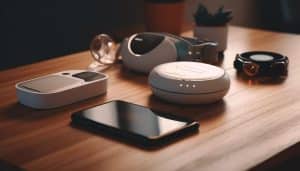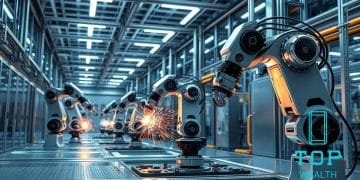AI sensors used in smart devices across industries

AI sensors used in smart devices enhance performance by collecting real-time data, enabling personalized experiences, and improving efficiency across various industries like healthcare, automotive, and retail.
AI sensors used in smart devices across industries are transforming the way we interact with technology. Ever wondered how they enhance our daily lives? Let’s explore their impact!
Understanding AI sensors and their functions
Understanding AI sensors and their functions is essential for appreciating how they enhance smart devices. These sensors are critical components that gather data and provide insights that make devices smarter and more efficient.
AI sensors can be classified into several types, each serving unique functions. Their primary job is to detect and respond to various stimuli from the environment. For example, temperature sensors help manage HVAC systems, while motion sensors can enhance security systems in homes.
Types of AI Sensors
Various sensors utilize artificial intelligence to perform specific tasks:
- Optical sensors: These sensors detect light and can measure distances using light reflections. They play a significant role in cameras and automated lighting systems.
- Sound sensors: Known for their ability to recognize sounds, these sensors are often implemented in devices like smart assistants to understand voice commands.
- Pressure sensors: These sensors can measure changes in pressure and are frequently used in industrial applications to monitor machinery.
- Environmental sensors: Designed to monitor specific environmental conditions, they can measure air quality, humidity, and temperature, ensuring optimal operational conditions.
The integration of AI into these sensors allows for advanced data analysis. AI algorithms process sensor data and provide smarter solutions, making devices increasingly autonomous. For instance, a smart thermostat learns your temperature preferences over time and adjusts itself accordingly, optimizing energy consumption.
Furthermore, AI sensors are now capable of predictive maintenance. By analyzing data patterns, they can foresee potential failures and alert users before a system breakdown occurs. This proactive approach minimizes downtime and saves costs associated with repairs.
In summary, understanding AI sensors and their functions not only highlights their importance in smart devices but also underscores their impact across multiple industries.
Key industries leveraging AI sensors

Key industries leveraging AI sensors are reshaping the landscape of technology and innovation. Various sectors rely on these sensors to enhance efficiency and deliver improved services.
The automotive industry is one of the frontrunners in utilizing AI sensors. Here, they play a crucial role in the development of autonomous vehicles. AI sensors assist in recognizing road signs, detecting obstacles, and even navigating complex traffic situations. This technology is vital for ensuring safety and efficiency on the roads.
Healthcare Industry
In healthcare, AI sensors are transforming patient monitoring and disease management. With the help of wearable devices, doctors can track vital signs in real-time. These sensors collect data such as heart rate and oxygen levels, providing alerts for any critical changes.
- Smart wearables: Devices like smartwatches track fitness metrics and health conditions.
- Remote monitoring: AI sensors enable doctors to observe patients without them needing to visit a clinic.
- Diagnostic tools: Sensors help in identifying health issues early, allowing for timely intervention.
Moreover, the agriculture sector is leveraging AI sensors to improve crop management. Farmers use these sensors to monitor soil health, weather conditions, and moisture levels. By analyzing this data, farmers can make informed decisions that enhance yield and reduce waste.
The retail industry also benefits from AI sensors, particularly in understanding customer behavior. Sensors can monitor foot traffic and analyze shopping patterns. This information is crucial for optimizing store layouts and improving customer experiences. Retailers can also use AI sensors for inventory management, ensuring stock levels meet demand without excess.
Additionally, the manufacturing industry employs AI sensors to streamline operations. These sensors monitor machinery performance and can predict maintenance needs. By doing so, companies can prevent costly downtime and enhance productivity.
Overall, key industries leveraging AI sensors are leading the charge towards smarter and more efficient systems. Their application ranges from improving health outcomes to optimizing manufacturing processes.
How AI sensors improve smart device performance
How AI sensors improve smart device performance is a crucial topic for understanding the innovation behind modern technology. These sensors enable devices to become more responsive and efficient, meeting user demands and optimizing functionality.
One significant way AI sensors enhance device performance is through real-time data collection. For instance, smart home devices utilize AI sensors to monitor conditions like temperature, humidity, and light levels. By analyzing this data, devices can automatically adjust settings to create a more comfortable environment.
Enhanced User Experience
AI sensors also enhance the overall user experience by personalizing interactions. Smart speakers, for example, use voice recognition sensors to learn individual preferences over time. As they gather information about your likes and habits, they are able to provide more relevant recommendations and services.
- Adaptive learning: Devices learn user behaviors to optimize responses.
- Voice recognition: Understands commands to perform tasks like playing music or setting reminders.
- Smart notifications: Alerts you when conditions change, saving time and effort.
Furthermore, AI sensors play a critical role in energy efficiency. In smart appliances, sensors can determine when devices are in use and adjust power settings accordingly. This capability reduces energy consumption, leading to cost savings over time while also benefiting the environment.
Another notable aspect is predictive analytics. AI sensors analyze historical data to forecast future device performance. For example, smart thermostats can learn your heating preferences and adjust temperatures based on your daily routines. This not only enhances comfort but also contributes to energy savings.
Moreover, the integration of AI sensors allows for seamless connectivity between devices. This interconnectedness means that various smart devices can communicate with each other to adjust settings collectively. For instance, when you leave home, your security system can trigger lights to turn off, and the heating can lower, maximizing energy efficiency.
In summary, AI sensors significantly improve smart device performance by enhancing user experiences, optimizing energy use, and enabling predictive capabilities. Their advancement continues to shape how we interact with technology in our daily lives.
Challenges in the integration of AI sensors
Challenges in the integration of AI sensors present significant hurdles for industries looking to adopt cutting-edge technology. While AI sensors offer many benefits, their successful implementation is not always straightforward.
One major challenge is data privacy and security. As AI sensors collect vast amounts of data, concerns about how this information is stored and used arise. Organizations must ensure robust security measures are in place to protect sensitive data from breaches.
Technical Complexity
Additionally, the technical complexity of integrating these sensors within existing systems can be daunting. Companies often face difficulties in ensuring that new AI sensors can effectively communicate with older technology. Compatibility issues may require substantial investments in upgrades or replacements.
- Interoperability: Different AI sensor types need to work together seamlessly.
- Scalability: Systems must be designed to grow with increasing data demands.
- Maintenance: Regular maintenance is required to ensure optimal sensor performance.
Another significant obstacle is the cost of implementation. The initial expenses of acquiring and installing AI sensors can be substantial. Companies must weigh the potential long-term benefits against the upfront costs to decide on adoption.
Moreover, there is a risk of over-reliance on AI systems. When organizations depend too heavily on AI sensors, they may neglect the importance of human oversight and intuition. It’s crucial to find the right balance between automation and human involvement to maintain effective decision-making.
Finally, the rapid evolution of technology poses a unique challenge. With AI sensors advancing quickly, companies may struggle to keep up with the latest developments. Staying updated requires ongoing training and education for staff, further increasing costs and resource allocation.
In summary, while AI sensors promise improved efficiency and data-driven insights, several challenges in their integration must be navigated carefully. Addressing these challenges is essential for reaping the full benefits of this transformative technology.
Future trends for AI sensors in smart devices
Future trends for AI sensors in smart devices are set to revolutionize how we interact with technology. As advancements continue, AI sensors will play an even more integral role in enhancing device performance and user experience.
One significant trend is the rise of edge computing. This technology allows data processing to occur closer to where it is generated instead of relying on a centralized system. With AI sensors processing data on-site, devices can respond more quickly to user actions and environmental changes, minimizing latency and improving efficiency.
Increased Integration of Machine Learning
Another trend is the increased integration of machine learning algorithms. As AI sensors collect more data over time, they can learn and adapt to user preferences and behaviors. This means devices will become smarter and more intuitive, tailoring their functionality to better suit individual needs.
- Personalization: Devices will offer tailored recommendations based on user habits.
- Autonomous adjustments: Systems will adjust settings automatically without user intervention.
- Predictive maintenance: Devices will anticipate failures and alert users before issues occur.
Additionally, the development of miniaturized sensors is on the rise. Smaller sensors can be embedded into a wider variety of devices, expanding their application. This technology will enable even everyday items to become smart and connected, creating a more cohesive smart home ecosystem.
Furthermore, there is growing interest in biometric sensors. These sensors can read and analyze physical attributes like heart rate, facial recognition, and more. This trend opens up new possibilities in health monitoring and security features, making devices more secure and personalized for users.
Finally, advancements in security protocols will continue to evolve. As AI sensors become more prevalent, protecting user data will be paramount. Enhanced encryption and security measures will ensure that data collected by sensors remains private and secure from unauthorized access.
In summary, the future of AI sensors in smart devices promises to deliver significant improvements in functionality, personalization, and security. As these trends continue to unfold, users can expect a more integrated and seamless interaction with their smart devices.
In conclusion, AI sensors are transforming the landscape of smart devices, driving advancements across various industries. Their ability to collect and analyze data in real-time enhances efficiency and user experience. As we look to the future, trends like edge computing, machine learning integration, and biometric sensors will continue to shape how we interact with technology. However, challenges remain, including ensuring data privacy and managing costs. Addressing these concerns will be crucial for maximizing the benefits of AI sensors in our daily lives.
FAQ – Frequently Asked Questions about AI Sensors in Smart Devices
How do AI sensors improve smart device functionality?
AI sensors collect real-time data and allow devices to respond quickly to user needs, enhancing overall performance and user experience.
What industries are benefiting most from AI sensors?
Industries like healthcare, automotive, agriculture, and retail are leveraging AI sensors to improve efficiency, security, and customer engagement.
What challenges do businesses face when integrating AI sensors?
Key challenges include data privacy concerns, compatibility issues with existing systems, high initial costs, and the need for ongoing maintenance.
What future trends can we expect for AI sensors?
Future trends include increased use of edge computing, advancements in machine learning, and the integration of biometric sensors for enhanced security and personalization.





